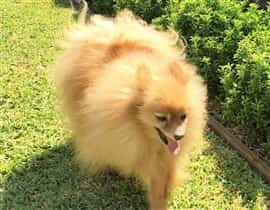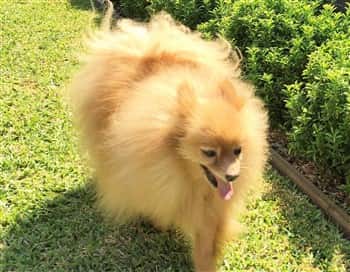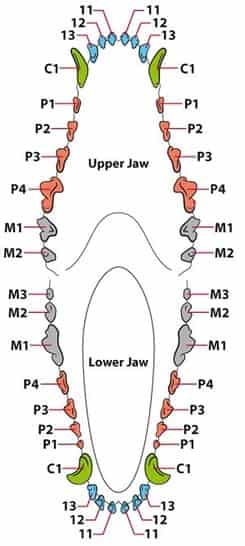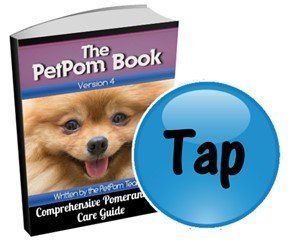Feeding Tips Pom with Missing Teeth
PetPom

The
Pomeranian
Information
Center
Feeding Tips for PomeraniansThat Are Missing Teeth
Overview
The most challenging aspect of finding the right food to feed a Pomeranian that is missing teeth is to offer the same high-quality diet as you would otherwise while ensuring that your Pom can easily chew or gum it. A dog’s diet is vital to both current and future health and lack of proper nourishment can lead to a variety of issues ranging from hypoglycemia to inability to maintain a healthy weight.
Since this breed is vulnerable to tooth decay and subsequent tooth loss, many owners of senior Poms find themselves in the predicament of choosing new foods after years of plaque and tartar has worn away at enamel and decay has damaged both the jaw bone and the gums. Though, it is also not uncommon for rescued Poms that have had a lack of dental hygiene to have had teeth extracted or to have suffered tooth loss due to neglect.
This article will cover what you need to know about choosing the best food for a Pomeranian with no (or few) teeth.


Benny, an 8-year-old rescue Pomeranian; Benny had to have all of his teeth removed, but he is a happy, playful little guy that eats mashed food and soft biscuits. Photo courtesy of David and Tony (from Australia)
How Many Teeth Must a Pomeranian Have to Properly Chew?
If your Pomeranian has had a few teeth extracted or is missing a couple of teeth, you may be wondering how many teeth have to be gone before there is a need to make a switch away from hard, dry kibble to a softer, more edible food.
The answer depends on which teeth are missing. Of the 42 teeth in an adult dog’s mouth, there are 4 categories:


Incisors (see blue on above image) - These are the small teeth in the front of the mouth. There are 6 on the bottom row and 6 on the top row. These are not used for chewing, but rather are useful for picking up things up (including food but also toys and such) and for nibbling on things (including themselves; for example, when itchy).
If one or more incisors are missing, a Pomeranian can most likely still eat their regular food. Do note, however, that if an incisor is extracted, you may be directed to offer soft food while the gum heals.
Canines
(see green on above image) – Also referred to as the fangs, there are just 4 in total. These come right after the incisors, with 2 on the bottom row and 2 on the top row. The canine teeth are used to bite and hold onto things. If a dog bites a person, it is the canines that the victim will be feeling. If a Pom is missing one or more canines, they can usually still eat their regular food, but it should be bite-sized.
Premolars
(see orange on above image) – These are the type of teeth that come next after the canines; there are 16 in total, with 4 on the lower left, 4 on the lower right, 4 on the top left, and 4 on the top right.
These are the main teeth that a dog uses to chew food. Those near the front are rather small but they get progressively larger toward the back. When a dog eats, they move the food to one side of the mouth and use the premolar’s surface area and pointy ends to grind up the food into pieces small enough to swallow.
If your Pomeranian is missing premolar teeth, whether or not hard food can still be eaten will depend on how many teeth are gone and which side(s) of the mouth the remaining teeth are located.
For example, if a Pom has just one missing premolar, this would rarely affect their ability to eat. And, if two, or even three, are missing from one side, many dogs would be able to compensate for this by keeping their food bits on the opposite side.
However, if 3 or more premolars are missing, and especially if the loss is on both sides of the mouth, this most often will mean that it would be difficult to eat hard kibble and doing so could present a choking hazard.
Signs of difficulty eating due to tooth loss include coughing out pieces of food, eating very slowly, dropping food pieces to the floor only to sniff at them with half-hearted attempts to mouth them, and/or refusal to eat.
Molars
(see gray on above image) – In the very back of the mouth are the molars; there are 10 in all: 3 on the lower left and 3 on the lower right, then 2 on the upper left and 2 on the upper right.
Molars do the real heavy work of breaking down hard and large pieces of food. For example, if a Pomeranian took in a large piece of a hard biscuit, he may push that piece back toward the molars to break it up, and then grind it with the premolars.
If one molar is missing, this would rarely affect a Pom’s ability to eat hard kibble. However, if several have been lost, only bite-sized hard food should be given. If one or more molars are missing, particularly on both sides and with the addition of one or more premolars missing, this may very well affect a dog’s chewing ability.
To Summarize thus far:
Many dogs can still eat hard kibble if they are missing some incisors and/or canine teeth. However, absent premolars (the most important teeth for chewing) may present problems. Absent molars may mean restricting anything larger than bite-sized kibble.
If your Pomeranian has lost some teeth, monitor their comfort level and chewing capability. If you have any doubts, consult your Pom’s veterinarian.
Recommended Diet for Pomeranians with Missing Teeth
If your Pomeranian has enough missing teeth that eating hard kibble has become impossible or dangerous, there are indeed easy methods to ensure that your Pom still eats a healthy diet and receives enough nutrition.
One of the biggest mistakes that owners make is panicking, assuming that nothing sort of a liquid diet will do… or, they assume that all dog food is out of the question and start to offer only bits of human food.
Here is what to do:
1. Stick with your Pom’s regular kibble, as a base, as long it is a high-quality food.
If you are not sure of your Pom’s food rating, Dog Food Advisor
is a great resource for this, which rates food from 1 to 5 stars. You will want your Pom to be on a 4-star food, at minimum.
Ratings are based on how well a food is balanced (protein/carbs/healthy fats) as well as the presence of extras like antioxidants, probiotics, and omegas, and the omission of negative ingredients like by-products, chemical preservatives, and artificial flavoring. Any past recalls are factored in as well.
If you are looking for a highly rated kibble to use as a base, Wellness Complete Health for Toy Breeds
 is a fantastic choice. Note that there is also a senior formula for dogs age 8 and up. This is a chicken and turkey base with rice (easily digestible since the hull is removed during the milling process), along with flaxseed, blueberries, peas, apples, carrots, spinach, and other nutrients ingredients. There is no wheat, corn, soy, meat by-products, artificial flavors or colors or chemical preservatives.
is a fantastic choice. Note that there is also a senior formula for dogs age 8 and up. This is a chicken and turkey base with rice (easily digestible since the hull is removed during the milling process), along with flaxseed, blueberries, peas, apples, carrots, spinach, and other nutrients ingredients. There is no wheat, corn, soy, meat by-products, artificial flavors or colors or chemical preservatives.
2. Then, prepare that base to be easily eaten.
Once you know that the base will offer your Pom what they need, it’s time to make it easy to chew or gum and safe to swallow.
In regard to how much food to offer, serving size does not change; it is based on weight and the labeling on the packaging will let you know how much your Pom should have. Do keep in mind that serving recommendations assume that you are offering your dog several small snacks per day (snacks suggestions are ahead).
Adding to the base is done by:
1) Adding liquid.
With the kibble in a microwavable bowl, add water. But, do not use unfiltered tap water which more often than not contains upward of 100 unregulated toxins; use bottled water or water that has been properly filtered via a device like the Aquagear Water Filter Pitcher .
.
Though it is not necessary, unless your Pom needs a bit more motivation, you can add both water and low-sodium chicken or beef broth. If so, do a 50/50 mixture.
It’s easy to remember how much water to add to kibble if your Pomeranian is missing their teeth: it’s equal amounts. So, 1/2 cup of kibble means 1/2 cup of liquid.
Set this aside for 15 minutes. During this time, the liquid will be soaked up into the kibble. This does vary depending on the exact brand that you are offering. If you find that it does not soak up all of the liquid, next time add a bit less water/broth.
2) Breaking the pieces apart with a fork.
Now that you have a bowl of soaked kibble, it’s time to mash it up for easier eating. If your Pom is just missing a few teeth, press the fork down into each piece to break it up. If your Pom is missing essentially all of their teeth, mash this until it is pureed.
3) Warming the food.
While this is not an absolutely necessary step, many Poms find warm food to be very appealing, so you may learn that this is an important step for your Pom to eat their entire meal.
Until you have done this enough to know exactly how long the food needs to reach a comfortable warmth, microwave it in increments of 10 seconds. To test it, stir it up well and use your finger to test the temperature.
3. If you are considering switching your Pom to a canned food,
keep in mind that the ingredients most likely need to be chopped up since this often contains pieces large enough to be a choking hazard. Some canned dog food contains shredded meats, which can be difficult to properly dice by hand.
In addition, bear in mind that canned food can lead to more frequent or runny bowels.
It is for these reasons that kibble as a base is the preferred method.
Treats to Give to a Pomeranian with Missing Teeth
While some may assume that reward treats are only applicable to puppies, this is not true at all. It’s wise to show dogs of any age that they are going a great job. Offering praise and reward can help reinforce training such as housebreaking, commands, and heeling, and are a good way to show a dog that you appreciate their good behavior, whether it is sitting still while you brush the coat or behaving while you have visitors over.
If your Pom still has enough teeth that they are able to chew on soft treats, there are a couple of great options. One that has recently come to attention is Full Moon Organic Training Treats . These are human-grade organic soft treats designed for small dogs and can be found in both duck and chicken flavors. These are all natural, with no artificial flavors or preservatives and no corn, soy, or wheat. These are made in the USA.
. These are human-grade organic soft treats designed for small dogs and can be found in both duck and chicken flavors. These are all natural, with no artificial flavors or preservatives and no corn, soy, or wheat. These are made in the USA.
Another great choice is WellBites Natural Grain-Free Treats . These are all-natural and made in the USA as well. There’s lots of great flavors to choose from including beef & turkey, chicken & lamb, chicken & venison, lamb & salmon, and turkey& duck.
. These are all-natural and made in the USA as well. There’s lots of great flavors to choose from including beef & turkey, chicken & lamb, chicken & venison, lamb & salmon, and turkey& duck.
If you want to offer some homemade treats, some terrific options for Pomeranians missing some or all teeth include mashed banana, whole white yogurt, mashed potatoes, and soft fruits like blueberries and raspberries (these can be mashed, if needed). These should all be given in moderation and feel free to mix two or more of these for yummy combinations. The mashed banana can be mixed with some all-natural smooth peanut butter, that can be rolled into balls or given off of a spoon.
A Final Word
Though Pomeranians that are missing too many teeth will not be able to eat hard kibble, it is entirely possible to still ensure that your little guy or gal is eating a healthy diet.
For any teeth that do remain, work extra hard to keep them in good shape via at-home dental cleanings, which may include brushing or, if your Pom resists that, a no-brush option like Gel Me: Doggy Dental Gel . And, of course, continue to bring your Pomeranian to the vet for regular wellness checks.
. And, of course, continue to bring your Pomeranian to the vet for regular wellness checks.
Related:
Best Toys for Pomeranians that are Missing Teeth
- There are benefits to toys aside from chewing such as keeping a dog occupied and offering mental stimulation. See some great recommendations in all toy categories.
You May Also Like:
Foods a Pomeranian Can and Cannot Eat
- If you're interested in home cooking or just looking for some wholesome snacks, see a complete list of safe and unsafe foods.
How to Keep a Pomeranian Safe
- The top 15 ways to keep your Pom super safe. How many are you doing?
Pomeranian is Scared of Loud Noises
- From thunder to fireworks and even the vacuum cleaner, some dogs are terribly afraid of loud sounds; learn why this is and exactly how to help your little guy or gal.
How to Fix Tear Stains on a Pomeranian
- If your Pom has discoloration under or around the eyes, it'll take a bit of work but these can be fully removed.
If you email photos to us, you agree that PetPom is given free copyright to use at our discretion. We will always credit the photo to the name of the Pom's owner(s) if it is supplied.
Email: Contact@PetPom.com
All text, images and artwork protected by US and International copyright laws. All rights reserved. Copyright PetPom.com
We are a participant in the Amazon Services LLC Associates Program, an affiliate advertising program designed to provide a means for us to earn fees by linking to Amazon.com and affiliated sites.

